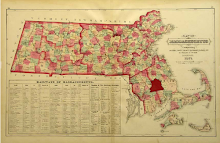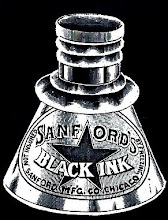 Prior to the propagation of cranberries, one of Middleborough’s principal fruit crops had been the wild huckleberry. While huckleberries may never have proved a crop of enormous commercial value for Middleborough, their role in the social history of the community is, nonetheless, noteworthy, and recorded references to huckleberrying are frequent in the period preceding the First World War.
Prior to the propagation of cranberries, one of Middleborough’s principal fruit crops had been the wild huckleberry. While huckleberries may never have proved a crop of enormous commercial value for Middleborough, their role in the social history of the community is, nonetheless, noteworthy, and recorded references to huckleberrying are frequent in the period preceding the First World War. Areas closer to Middleborough were likewise marked for their “considerable undergrowth of vines, huckleberry bushes and other shrubby plants.” Huckleberries thrived in both the swamps and uplands of South Middleborough, particularly, and they grew there in such abundance that they gave their name to nearby Huckleberry Corner in Carver near the end of Pine Street, where residents would sell their berries to the occupants of passing stages en route to New Bedford. Local residents would make their way into the woods each summer in search of the berry, and so great was their allure, that in August, 1879, a 90-year old woman is recorded as having "filled in some spare time this summer by picking a goodly quantity of huckleberries."
Areas closer to Middleborough were likewise marked for their “considerable undergrowth of vines, huckleberry bushes and other shrubby plants.” Huckleberries thrived in both the swamps and uplands of South Middleborough, particularly, and they grew there in such abundance that they gave their name to nearby Huckleberry Corner in Carver near the end of Pine Street, where residents would sell their berries to the occupants of passing stages en route to New Bedford. Local residents would make their way into the woods each summer in search of the berry, and so great was their allure, that in August, 1879, a 90-year old woman is recorded as having "filled in some spare time this summer by picking a goodly quantity of huckleberries." Wild huckleberries were picked also for sale throughout the last decades of the nineteenth century. In 1875, Middleborough produced 4,756 quarts of the berry valued at $421, a not inconsiderable amount when contrasted with the value of Middleborough’s other agricultural output. At the time, Middleborough ranked third in the production of huckleberries in Plymouth County, behind Scituate and Marshfield. The Gazette, noting the local sales from its woods and dairy farms remarked “only think of the bowls of huckleberries and milk.”
 Attempts were made at Middleborough, as elsewhere, to commercially exploit this natural bounty and, in July, 1885, an unnamed South Middleborough man was in fact shipping several crates of huckleberries a week to Nantucket, reportedly “doing a good business … and realizing good prices.” However, because the huckleberry plant was wild and had yet been domesticated, harvests were highly dependent upon the vagaries of nature. In November, 1902, it was reported that “South Middleborough bushes have become so twisted as to the season that they have been blossoming.” On October 25, 1913, the Gazette reporter was shown a cluster of ripe huckleberries and blossoms on the same branch by Elmer Hatch who just previously had been able to harvest enough berries for a pie. In 1919, South Middleborough residents were surprised to find ripe huckleberries as early as June.
Attempts were made at Middleborough, as elsewhere, to commercially exploit this natural bounty and, in July, 1885, an unnamed South Middleborough man was in fact shipping several crates of huckleberries a week to Nantucket, reportedly “doing a good business … and realizing good prices.” However, because the huckleberry plant was wild and had yet been domesticated, harvests were highly dependent upon the vagaries of nature. In November, 1902, it was reported that “South Middleborough bushes have become so twisted as to the season that they have been blossoming.” On October 25, 1913, the Gazette reporter was shown a cluster of ripe huckleberries and blossoms on the same branch by Elmer Hatch who just previously had been able to harvest enough berries for a pie. In 1919, South Middleborough residents were surprised to find ripe huckleberries as early as June. Clearly, as long as huckleberries remained uncultivated, they would never form the basis for a successful or stable commercial enterprise, though South Middleborough natives readily took advantage of the crop in the years when it was available to them. Elmer Hatch, in particular, had an especial knack for locating the ripe berry. “We think Elmer Hatch must have been about the first to find ripe huckleberries, as it was three weeks ago he reported them.” In September, 1919, Hatch was still able to locate ripe berries, picking several quarts and bringing “home bushes with a good display of large blue ones which were as nice as those of the earlier part of the season.”
Clearly, as long as huckleberries remained uncultivated, they would never form the basis for a successful or stable commercial enterprise, though South Middleborough natives readily took advantage of the crop in the years when it was available to them. Elmer Hatch, in particular, had an especial knack for locating the ripe berry. “We think Elmer Hatch must have been about the first to find ripe huckleberries, as it was three weeks ago he reported them.” In September, 1919, Hatch was still able to locate ripe berries, picking several quarts and bringing “home bushes with a good display of large blue ones which were as nice as those of the earlier part of the season.”USGS Map, Snipatuit, 1943.
.






















+of+Smoky+Mountains+018.jpg)
0 comments:
Post a Comment